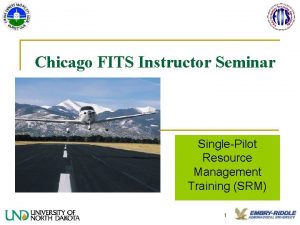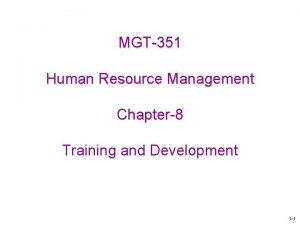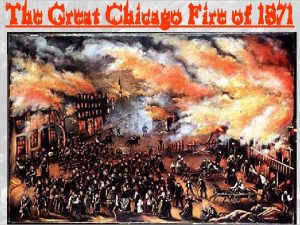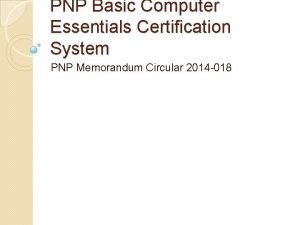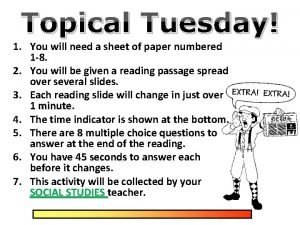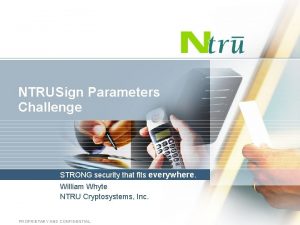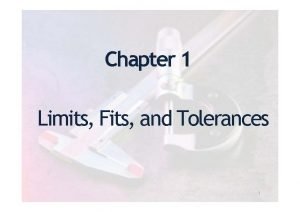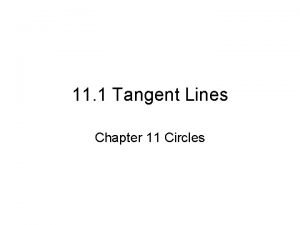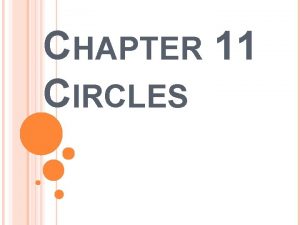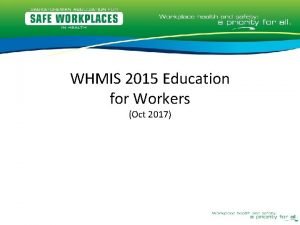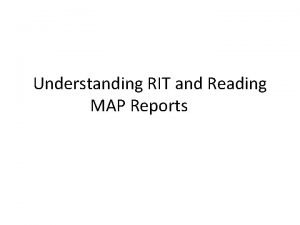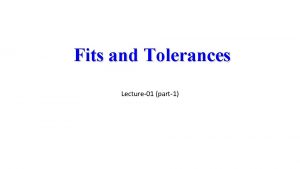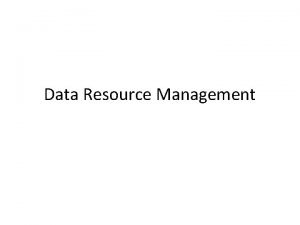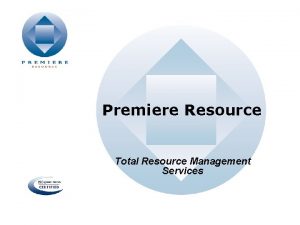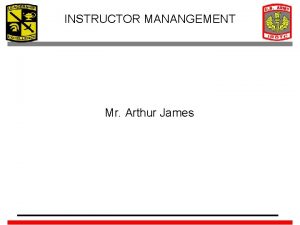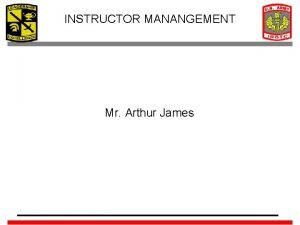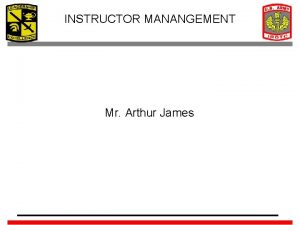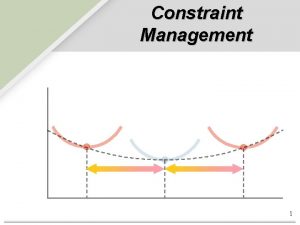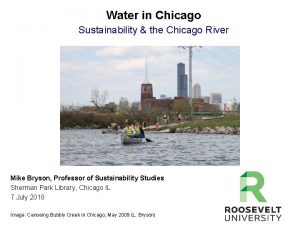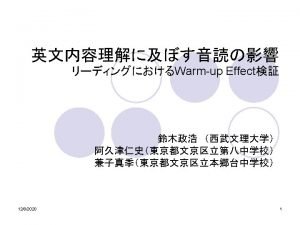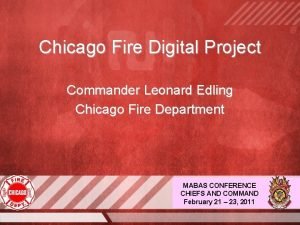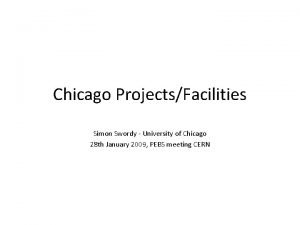Chicago FITS Instructor Seminar SinglePilot Resource Management Training






















- Slides: 22

Chicago FITS Instructor Seminar Single-Pilot Resource Management Training (SRM) 1

Why Not CRM? n n Crew Resource Management is about relationships! Cockpit Resource Management is about systems and equipment! CRM works best in a highly structured crew environment CRM is well suited to Airline Operations but is not a “best fit” for General Aviation 2

Single-Pilot Resource Management Training (SRM) n Is the art and science of managing all resources (both from on-board and external sources) available to the single-pilot (prior to and during flight) to ensure the successful outcome of the flight. 3

SRM n n Single Pilot Resource Management is about the unique situations we find ourselves in the “Technically Advanced Aircraft” q Weather q Traffic q Cockpit Automation q Data-Link Systems q Passengers Follows the lead provided by the airline industry to improve flight safety through CRM training. Human factors-related accidents motivated the airline industry to implement CRM training for flight crews. Now, pilot-error related accidents are motivating single-pilot operators to implement SRM training. 4

SRM Training Focuses On n n n Situational Awareness Task management Automation management Risk Management Aeronautical Decision making CFIT Awareness 5

TAA 01 Single Pilot Resource Management (SRM) Unit Objective – Demonstrates safe and efficient operations by adequately managing all available resources. Performance Conditions Standards The training task is: The training is conducted during: The pilot in training will: 1. Task Management (TM) Note: All tasks under SRM will be embedded into the curriculum and the training will occur selectively during all phases of training. SRM will be graded as it occurs during the training scenario syllabus. SRM Starts with Initial Training: Prioritize and select the most appropriate tasks (or series of tasks) to ensure successful completion of the training scenario. 2. Automation Management (AM) Program and utilize the most appropriate and useful modes of cockpit automation to ensure successful completion of the training scenario. 3. Risk Management (RM) and Aeronautical Decision Making (ADM) Consistently make informed decisions in a timely manner based on the task at hand a thorough knowledge and use of all available resources. 4. Situational Awareness (SA) 5. Controlled Flight Into Terrain (CFIT) Awareness And continues throughout A Pilots Career! Be aware of all factors such as traffic, weather, fuel status, aircraft mechanical condition, and pilot fatigue level that may have an impact on the successful completion of the training scenario. Understand, describe, and apply techniques to avoid CFIT encounters: a. During inadvertent encounters with Instrument Meteorological Conditions during VFR flight b. During system and navigation failures and physiological incidents during IFR 6 flight

AC 120 -51 c Says: Good training for routine operations can have a strong positive effect on how well individuals function during times of high workload or high stress. During emergency situation, it is highly unlikely (and probably undesirable) that any crewmember [pilot] would take the time to reflect upon his or her CRM [SRM] training in order to choose the appropriate behavior. But practice of desirable behaviors during times of low stress increases the likelihood that emergencies will be handled effectively. Emergency Escape Maneuver What this means to us: TAA pilots should make SRM procedures a regular part of every flight. A well practiced habit that can be relied upon in times of stress. Before SRM can become a habit, we have to learn it!! 7

The SRM 5 P Check: n The “ 5 P” Check q The Plan? q The Plane? q The Pilot? q The Passengers? q The Programming? n The “Decision Points” q q q Before Leaving the Flight Planning Room Before Leaving the Ground Hourly SRM Updates (Every Second Fuel Check? ) Before Leaving Cruise Altitude Before Leaving the IAF 8

SRM “ 5 P” Check n The Plan? q Weather? q Route? q Publications? q ATC Reroutes and Delays? q Fuel Remaining? n The Plane? q Mechanical Status? q Automation Status? q Database Currency? q Circuit Breakers? q Backup Systems? 9

SRM “ 5 P” Check n The Pilot? q “I”llness? q “M”edication? q “S”tress? q “A”lcohol q “F”atique q “E”ating n The Passengers? q Pilots or Non pilots? q Nervous or Quiet? q Experienced or New? q Helpful or a Handful? q Urgent or Optional? q Business or Pleasure? 10

SRM “ 5 P” Check n The Programming: q Preprogram the: n n n q Anticipate: n n q Autopilot? GPS? MFD/PFD? Likely Reroutes and Clearances? “Crunch” Points? Manual Backup? High terrain Encounters? Question: n n n What’s it doing? Why is it doing that? Did I Do That? 11

SRM Decision Process At several predetermined decision points consider the following! n What's the situation? The 5 P’s (Plan, Plane, Pilot, Passengers, and Programming) q What's changed since your original Go/No Go decision. q What negative outcomes are we more exposed to? n Engine failure n Avionics failure n Missed approach n Pilot overload n Mistakes on approach / final n CFIT n Fuel exhaustion n Icing or loss of control 12

SRM Decision Process At several predetermined decision points consider the following! n What can we do to minimize the increased risk associated with those outcomes? q Use automation to reduce workload / increase awareness. q Use MFD to maintain terrain awareness, etc q Use passengers to share workload / monitor environment q Request n A simpler approach n Single frequency approach n Vectors to final n Declare min fuel n Ask for altitude / routing change n Turn down "difficult" ATC requests 13

SRM Decision Process At several predetermined decision points consider the following! n n Prioritize tasks q If we can't do everything well, at least get the important things right. q What are they? q What can we "shed“ Is the resulting risk acceptable? q Would I have taken off knowing this was going to happen? q If not, divert / terminate the flight early 14

Sample SRM Scenario n n n Group Discussion of Real Time SRM Application No “right answers” Non attribution!!! Apply the “ 5 P” process to a basic flight situation Prepare for the scenarios to follow! 15

Sample SRM Scenario n Before leaving the Flight Planning Room q Plan - Indianapolis to Atlanta n VFR at Indy n MVFR enroute n MVFR at ATL n q Plane n q q 1400 hrs Local/January 17 Returning the plane to home base after an annual inspection Pilot n Last flight three weeks ago n Last IFR approach also three weeks ago Passengers n Pilot, spouse and two children Lets review the “ 5 P” Check It is a lot easier to cancel a flight before you have loaded everyone in the plane? Anonymous 16

Sample SRM Scenario n Before Takeoff q Plan n Clearance delivery gives a new routing to ATL n Tower advises ATL is undergoing flow control delays q Plane n Autopilot fails the preflight check q 15 minute repair (popped CB) Engine requires three tries to start but seems to run well Pilot? n 7 hrs sleep, arose at 0800 Passengers n 45 minute delay for child who is not feeling well Programming n Pilot can’t seem to find “dopey” intersection along V 53 n Rest of route programs as planned n q q q “ 5 P” Check 17

Sample SRM Scenario n One Hour After Takeoff q Plan n q Plane n n q Feels good but seems to make minor mistakes while programming the GPS Passengers n q Oil temp has gone up 15 degrees Oil pressure constant Pilot? n q ATL Center requires a position report passing “dopey” ATL ceiling and vis is dropping to 1800 ft, 2 miles, “BR” Center asks for a descent to 3, 000 ft Sound asleep Programming n You notice the Jepp database out of date on the GPS? “ 5 P” Check 18

Sample SRM Scenario n Before Leaving Cruise Altitude q q q Plan ATL gives you a hold for 30 minutes for flow control ATC advises you to expect extended vectors to final to 25 R ATL weather 1100 OVC/1 mile, BR Plane n n n q Pilot? n n q Feels good Did miss a couple of radio calls Passengers n q Oil temp is up 8 more degrees Oil pressure is down 3 lbs Autopilot breaker pops again, won’t reset Sound asleep Programming n Final approach fix in the GPS for 25 R has a different name than on the Jepp charts “ 5 P” Check 19

Sample SRM Scenario n Before Leaving IAF q Plan n ATL weather is 800 ft, ¾ mile and continuing to deteriorate n q q Plane n Oil pressure is down 2 more lbs n Trace ice appears on the windshield Pilot n q Awake, seemingly alert, a little irritable Passengers n n q ATC advises you to change to the ILS for the left runway instead of the right Awake now Younger child is crying Programming n n n Can’t seem to delete the 25 R approach and insert the 25 L Took three tries to program the approach Made same key stroke error twice “ 5 P” Check 20

The “ 5 P’s” At each decision point? n n q n The “Decision Points” q Before Leaving the Flight Planning Room? q Before Leaving the Ground? q Hourly SRM Checks? q Before Leaving Cruise Altitude? q Before Leaving the IAF? q n What is the situation? What are the tasks? How can automation help? What is the risk involved? How can risk be reduced? Are there terrain issues? What is my decision? n q q q The “ 5 P” Check The Plan? The Plane? The Pilot? The Passengers? The Programming? Failure to make a decision, is a decision!! 21

Other references? ? FITS Website http: //www. faa. gov/education_research/training/fits/ AOPA Single Pilot Awareness Program http: //www. aopa. org/asf/single_pilot_ifr/ 22
 Atlweather
Atlweather Methods of training in human resource management
Methods of training in human resource management Fire extinguisher training chicago
Fire extinguisher training chicago Resource leveling is the approach to even out the peaks of
Resource leveling is the approach to even out the peaks of Perbedaan resource loading dan resource levelling
Perbedaan resource loading dan resource levelling Time management in human resource management
Time management in human resource management Human resource requirements of a retail organization
Human resource requirements of a retail organization Management is universal and everywhere
Management is universal and everywhere Computer training seminar memo
Computer training seminar memo National training seminar
National training seminar Which fits best in the empty box above?
Which fits best in the empty box above? Strange fits of passion poem
Strange fits of passion poem Security that fits everywhere
Security that fits everywhere Limits fits and tolerances lecture notes
Limits fits and tolerances lecture notes Limits fits and tolerances
Limits fits and tolerances Find the value of x
Find the value of x Limits fits and tolerances lecture notes
Limits fits and tolerances lecture notes Judicial branch clip art
Judicial branch clip art Circles chapter 11
Circles chapter 11 What does structure fits function mean
What does structure fits function mean Pictograms can be easily identified because they have a
Pictograms can be easily identified because they have a One size fits all
One size fits all Analytical learning vs inductive learning
Analytical learning vs inductive learning
